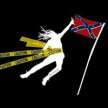Confederate Flags, Kneeling, and the USA: Part 1
Slavery in America

There seems to be a lot of controversy in the world today. We have protests on both sides, civil unrest, innocent people being murdered, and we don’t have a clue how to stop it. It is, in my opinion, a socio-economic and equality issue. “If we can keep the people poor and enslaved, they can’t rise up.”
I have no problem with people keeping confederate flags in their house. That is their property and their business. My problem is when it is displayed publicly on a courthouse or other building. While I believe in honoring your heritage (I’m sure I had family member fight on both sides), the fact of the matter is that by displaying and supporting the Confederate side, you are committing treason and would be labeled an enemy of the state. The reason I say this is because you are on the side that fought against the side that eventually became the United States.
One of the biggest slogans out there used in the debate is “heritage, not hate.” While I’m sure that this does apply to some people, please remember that the confederacy was pro-slavery. It’s easy for them to tell people of color to get over what their ancestors did to the slaves, but meanwhile, they are clinging to their flag for dear life. When the constitution was written, slaves were only considered three fifths of a person. They weren’t even considered a person, but a fraction of one. Sometimes I feel like this still applies to minorities through history and even today.
Slavery actually has been around for quite some time; however, it came to America around 1619. When the Jamestown settlers came to the new land, a Dutch ship brought approximately 20 slaves with them. They found this to be more efficient than the indentured servants they had in Europe. This continued to spread through the new colony. While there isn’t an actual figure, it is believed that between six and seven million slaves were brought to the new world during the 18th century. This took away some of the best and ablest men and women from Africa. In 1770, a leader and spokesman for patriotism was killed in the Boston massacre. His name was Crispus Attucks, and he was a former slave. During the revolutionary war, it is believed that over 5,000 African people fought for the American side.
The slaves generally worked in tobacco and rice fields during the 17th and 18th centuries along the southeast coast. When the American Revolution was over, a lot of the northern states began to link the oppression of slavery to the oppression that they had suffered under the British, and wanted to call for abolition of slavery. However, slavery was an institution in the constitution, as I stated earlier, counting each slave as three fifths of a person for taxation and representation purposes. When the lands used to grow tobacco became weary, slavery became a doubt. However, in 1793, the cotton gin was invented by Eli Whitney, which made slavery and cotton a booming industry that pulled the south’s economy back out from the brink of disaster.
Slavery itself was never big across the north; however there were some northern businessmen who became rich buying and selling slaves. Between 1774 and 1804, slavery had been abolished in the north. However, it remained an institution in south and its economy. The slave trade nearly tripled in the US in the next 50 years. In 1860 there were nearly four million slaves, with over half living in the south, working in the cotton fields.
Slaves made up about a third of the population in the south at the time, usually working on plantations. Slave owners normally owned less than 50 slaves at a time. This helped the owners make the slaves completely dependent on their masters. They were restricted from learning to read and write, their movements were limited, and a lot of the female slaves were sexually assaulted by their masters. The slaves were kept divided as a whole, through a strict hierarchy that ranged from house slaves to lowly farm slaves to keep them divided, making an uprising less likely. The slave marriages had no legal grounds, although many did get married and raise families. The owners often encouraged this to make profits off the slaves, and had no problems dividing families to make financial gains.
Slave revolts did happen in 1800 and 1822, but were not successful. A slave named Nat Turner led a rebellion in South Hampton County, Virginia in August of 1831, which saw approximately 75 blacks murder over 60 whites in two days until armed owners and the state militia arrived and overwhelmed the slaves. They used this case as an argument that the slaves were “nothing but nefarious barbarians, and required slavery to discipline them. Fears of many slave owners over another uprising made them enforce stricter codes upon the slaves, including movement and assembly.
Between the 1830s and 1860s, the abolitionist movement began to gain strength. With the likes of Frederick Douglass and Harriet Beecher Stowe, as well as a white supporter named William Lloyd Garrison, who founded the radical newspaper known as The Liberator. Free blacks and anti-slavery northerners began to have a network of safe houses and helped fugitive and escaped slaves in 1780. In 1830, a larger movement began, known as the Underground Railroad, and began to take off. It is believed to have helped between 40,000 and 100,000 slaves attain freedom. This began to fan flames between the north and south.
This would reach a breaking point when Abraham Lincoln, a republican, became president. Seven states seceded to form the Confederate States of America, with four more after the Civil War. The purpose of the Union war was not to abolish slavery, but preserve the US as a nation. Abolition only became important due to military necessity and self-emancipation of the slaves from the north. After the final and bloody battle at Antietam in September of 1862, Lincoln made a preliminary emancipation proclamation, which didn’t become official until January of 1863. The war continued until 1865, and 38,000 black soldiers lost their lives. This put a great strain on labor and production in the south.
The slaves gained rights to vote and be protected equally; however, these rights were mostly violated and ignored. The Ku Klux Klan triumphed in 1877 in the south, making violence and regression against the former slaves and people of color.
It wasn’t until the Civil Rights movement of the 1960s that the African American community began to gain a foothold on equality, although we still have a long way to go (This will be touched on in later parts).
About the Creator
James Howell
Father, activist, man in black... He/Him






Comments
There are no comments for this story
Be the first to respond and start the conversation.